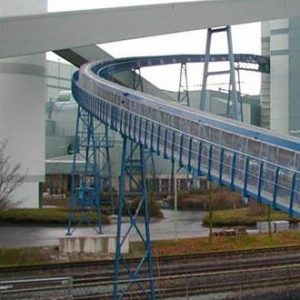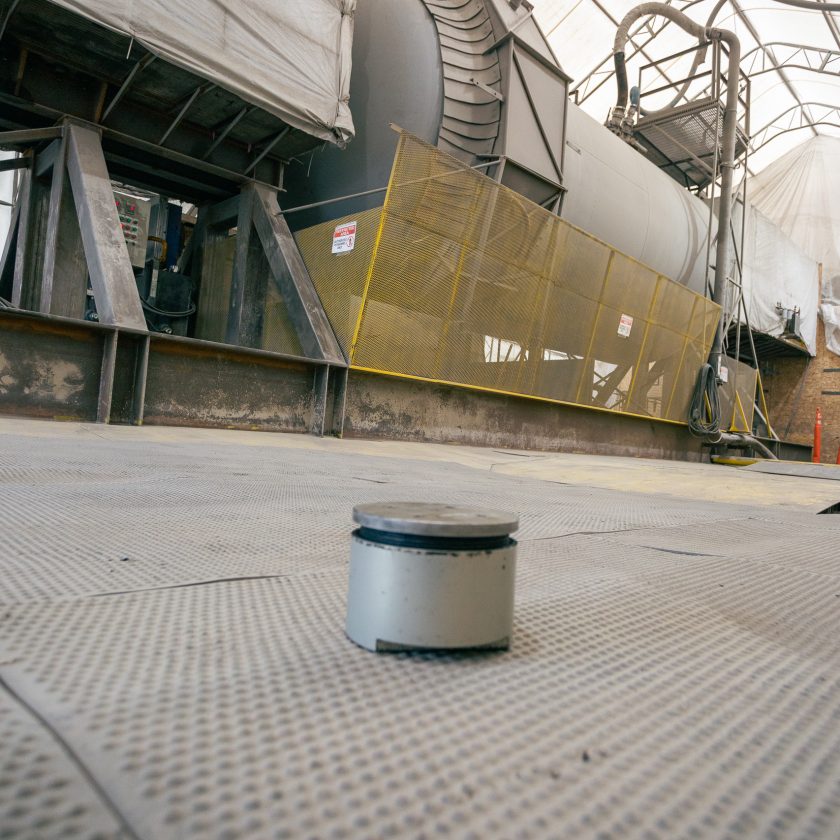Producers Can Expect Improved Efficiency, Capital And Operating Costs, And A Conveying Process That Is Environmentally Friendly And Sustainable.
By Simon Shipp
 The modern industrial process plant is often more sophisticated than the bulk transport method connecting it to its raw materials. Advances in overland conveyor technology have improved efficiency, capital and operating costs, and made the conveying process more environmentally friendly and sustainable. This makes overland conveying considerably more attractive and economically feasible versus trucking.
The modern industrial process plant is often more sophisticated than the bulk transport method connecting it to its raw materials. Advances in overland conveyor technology have improved efficiency, capital and operating costs, and made the conveying process more environmentally friendly and sustainable. This makes overland conveying considerably more attractive and economically feasible versus trucking.
The belt conveyor is the most reliable and proven method to transfer bulk materials like cement long distances at a low cost per ton. The cost per ton is really not a consideration for short in-plant conveyors moving materials short distances. These short in-plant conveyors, if properly designed, can run for years with little maintenance or repair and the cost per ton is usually not a consideration.
Some sophisticated operations move bulk materials long distances that demand a level of control, flexibility and environmental management that significantly exceeds the capabilities of the standard in-plant belt conveyor. Today technology exists that enables belt conveyors to transfer difficult materials in a totally enclosed manner which provides low operating costs per ton, environmental protection, routing flexibility and reliability that outclass not only the traditional belt but also all transfer formats including trucking.
Distance, route and material are no longer an obstacle to this application. Materials can be transferred spillage free in both directions adding a level of flexibility unimaginable in the past.
The two most flexible types of overland conveyors are the pipe conveyor and curved trough conveyor. There are advantages to both types.
In general the overland curved trough conveyor can carry a higher capacity of material than the pipe conveyor but the pipe conveyor can turn corners with shorter radii. Both have their place in the overland conveying of bulk solids and both can save civil costs of installation and reduce the operating costs when compared to trucking.
The Limitations of Existing Belt Conveyors
A modern belt conveyor has the ability to handle a range of bulk materials that behave in a certain way. As the material becomes more fluid in behavior or contains more moisture the standard belt conveyor becomes less applicable.
 |
 |
The ability to mitigate dusting at feed points, during transfer and at the discharge point with conventional conveyors is problematic. Unavoidably, the nature of the design means that with some materials you run the risk of blowing dust and spillage impacting the environment.
Straight belt conveyors can convey unbroken over long straight distances, but require costly transfer towers to change direction. Each time a direction change is needed the material has to be discharged and fed onto the next downstream conveyor. This creates transfer points and risk of dust escaping.
This may also create material degradation due to the impact associated with the transfer which increases dusting from degradation and drives wear when handling abrasive materials. Straight belt conveyors can easily reach a maximum inclination angle, and depending on the material this can often be at little more than 12 degrees.
The exact layout of a conveying system, particularly in-plant conveying systems, now depends on many factors and many different types of conveyors. But still, the elimination of transfer towers is a prime goal of any design. For overland conveyors the distance has to be greater to enjoy the benefits. Sometimes in-plant conveyors must include multiple transfer points.
Belt conveyors providing interplant transfer are highly viable and are often employed successfully across multiple industries.
The limitations of the traditional belt conveyor really start to show over increasing distances as changing topography creates more difficult and costly elevated sections of conveyor. Creating long straight conveyor runs over distance is simply more problematic and expensive. Frequently the decision to avoid belt conveyors entirely is made and the easier solution of trucking is taken. However, often this results in a missed opportunity to save money over time in the form of reduced costs per ton.
Conveying vs. Trucking
Assessing the costs of conveying versus trucking is easy but is often not done because of perceived complexities. This misses a major opportunity to save money. Table 1 shows a brief comparison of the advantages of each.
| Table 1 | ||
| Trucking | Traditional Belt Conveying | |
| Installation Cost | No fixed installation needed | Installation required |
| Power Requirement | Less efficient diesel engines | Highly efficient electric motors on drives |
| Capacity | Depending on truck numbers high | High capacity levels attainable |
| Level of Enclosure | Limited or none | Enclosed |
| Cost per Ton Moved | High | Low |
| Maintenance Cost | High and frequent | Low and limited |
| Routing | Very flexible, subject to road conditions | Very flexible |
| Environmental Impact | High | Low |
When it comes to transporting bulk material like cement, the key variable is tons per year that need to be transported. The power cost to convey one ton of material by conveyor is very low compared to what it costs to transport the material by truck, typically a $3.00 per ton difference. The economic incentive to install conveying is therefore most valuable if sufficient volume exists.
This does not mean trucking is dead either, but it does mean that assessing the needs and defining if modern belt conveying techniques can help is essential. One should model the net present value of the cost savings of conveying versus trucking whenever the volume is significant i.e. where it is possible to save money via conveying.
Conclusions
Overland conveyors can mean significant cost savings over time to install and utilize conveying instead of trucking. And when looking at projects with significant volume, capital investment required can pay for itself in a relatively short period.
The revolution in advance belt conveyor design means we have options now to transfer without dust, no material spillage, and safe with the knowledge that we can protect our environment. So the advantages are not just economic.
Modern belt conveyor technology enables more flexible angles, high rates, long distances and zero environmental impact belt conveying. Valuable materials can be kept from weather impact, reducing waste and ensuring consistent product quality. No business handling bulk materials can ignore this game-changing technology.
Simon Shipp is president of BEUMER Kansas City, LLC. BEUMER Group is an international manufacturing leader in intralogistics in the fields of conveying, loading, palletizing, packaging, sortation and distribution technology.




